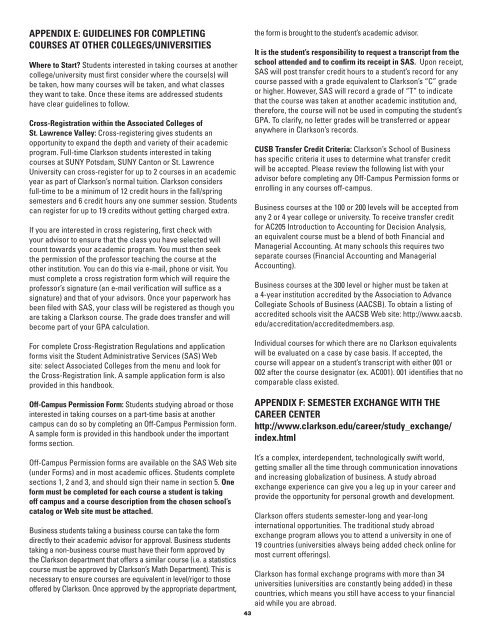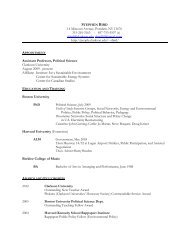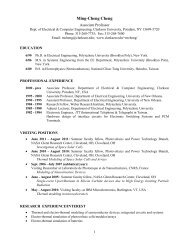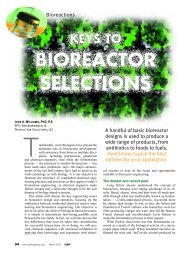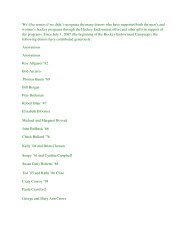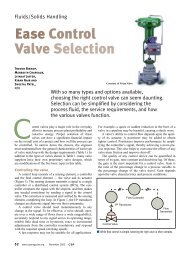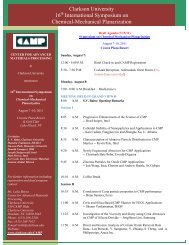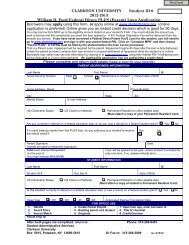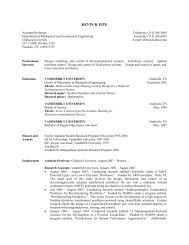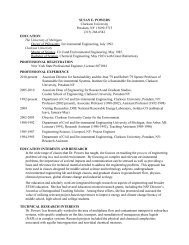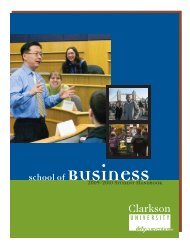School of Business - Clarkson University
School of Business - Clarkson University
School of Business - Clarkson University
Create successful ePaper yourself
Turn your PDF publications into a flip-book with our unique Google optimized e-Paper software.
APPENDIX E: GUIDELINES FOR COMPLETING<br />
COURSES AT OTHER COLLEGES/UNIVERSITIES<br />
Where to Start? Students interested in taking courses at another<br />
college/university must first consider where the course(s) will<br />
be taken, how many courses will be taken, and what classes<br />
they want to take. Once these items are addressed students<br />
have clear guidelines to follow.<br />
Cross-Registration within the Associated Colleges <strong>of</strong><br />
St. Lawrence Valley: Cross-registering gives students an<br />
opportunity to expand the depth and variety <strong>of</strong> their academic<br />
program. Full-time <strong>Clarkson</strong> students interested in taking<br />
courses at SUNY Potsdam, SUNY Canton or St. Lawrence<br />
<strong>University</strong> can cross-register for up to 2 courses in an academic<br />
year as part <strong>of</strong> <strong>Clarkson</strong>’s normal tuition. <strong>Clarkson</strong> considers<br />
full-time to be a minimum <strong>of</strong> 12 credit hours in the fall/spring<br />
semesters and 6 credit hours any one summer session. Students<br />
can register for up to 19 credits without getting charged extra.<br />
If you are interested in cross registering, first check with<br />
your advisor to ensure that the class you have selected will<br />
count towards your academic program. You must then seek<br />
the permission <strong>of</strong> the pr<strong>of</strong>essor teaching the course at the<br />
other institution. You can do this via e-mail, phone or visit. You<br />
must complete a cross registration form which will require the<br />
pr<strong>of</strong>essor’s signature (an e-mail verification will suffice as a<br />
signature) and that <strong>of</strong> your advisors. Once your paperwork has<br />
been filed with SAS, your class will be registered as though you<br />
are taking a <strong>Clarkson</strong> course. The grade does transfer and will<br />
become part <strong>of</strong> your GPA calculation.<br />
For complete Cross-Registration Regulations and application<br />
forms visit the Student Administrative Services (SAS) Web<br />
site: select Associated Colleges from the menu and look for<br />
the Cross-Registration link. A sample application form is also<br />
provided in this handbook.<br />
Off-Campus Permission Form: Students studying abroad or those<br />
interested in taking courses on a part-time basis at another<br />
campus can do so by completing an Off-Campus Permission form.<br />
A sample form is provided in this handbook under the important<br />
forms section.<br />
Off-Campus Permission forms are available on the SAS Web site<br />
(under Forms) and in most academic <strong>of</strong>fices. Students complete<br />
sections 1, 2 and 3, and should sign their name in section 5. One<br />
form must be completed for each course a student is taking<br />
<strong>of</strong>f campus and a course description from the chosen school’s<br />
catalog or Web site must be attached.<br />
<strong>Business</strong> students taking a business course can take the form<br />
directly to their academic advisor for approval. <strong>Business</strong> students<br />
taking a non-business course must have their form approved by<br />
the <strong>Clarkson</strong> department that <strong>of</strong>fers a similar course (i.e. a statistics<br />
course must be approved by <strong>Clarkson</strong>’s Math Department). This is<br />
necessary to ensure courses are equivalent in level/rigor to those<br />
<strong>of</strong>fered by <strong>Clarkson</strong>. Once approved by the appropriate department,<br />
43<br />
the form is brought to the student’s academic advisor.<br />
It is the student’s responsibility to request a transcript from the<br />
school attended and to confirm its receipt in SAS. Upon receipt,<br />
SAS will post transfer credit hours to a student’s record for any<br />
course passed with a grade equivalent to <strong>Clarkson</strong>’s “C” grade<br />
or higher. However, SAS will record a grade <strong>of</strong> “T” to indicate<br />
that the course was taken at another academic institution and,<br />
therefore, the course will not be used in computing the student’s<br />
GPA. To clarify, no letter grades will be transferred or appear<br />
anywhere in <strong>Clarkson</strong>’s records.<br />
CUSB Transfer Credit Criteria: <strong>Clarkson</strong>’s <strong>School</strong> <strong>of</strong> <strong>Business</strong><br />
has specific criteria it uses to determine what transfer credit<br />
will be accepted. Please review the following list with your<br />
advisor before completing any Off-Campus Permission forms or<br />
enrolling in any courses <strong>of</strong>f-campus.<br />
<strong>Business</strong> courses at the 100 or 200 levels will be accepted from<br />
any 2 or 4 year college or university. To receive transfer credit<br />
for AC205 Introduction to Accounting for Decision Analysis,<br />
an equivalent course must be a blend <strong>of</strong> both Financial and<br />
Managerial Accounting. At many schools this requires two<br />
separate courses (Financial Accounting and Managerial<br />
Accounting).<br />
<strong>Business</strong> courses at the 300 level or higher must be taken at<br />
a 4-year institution accredited by the Association to Advance<br />
Collegiate <strong>School</strong>s <strong>of</strong> <strong>Business</strong> (AACSB). To obtain a listing <strong>of</strong><br />
accredited schools visit the AACSB Web site: http://www.aacsb.<br />
edu/accreditation/accreditedmembers.asp.<br />
Individual courses for which there are no <strong>Clarkson</strong> equivalents<br />
will be evaluated on a case by case basis. If accepted, the<br />
course will appear on a student’s transcript with either 001 or<br />
002 after the course designator (ex. AC001). 001 identifies that no<br />
comparable class existed.<br />
APPENDIX F: SEMESTER EXCHANGE WITH THE<br />
CAREER CENTER<br />
http://www.clarkson.edu/career/study_exchange/<br />
index.html<br />
It’s a complex, interdependent, technologically swift world,<br />
getting smaller all the time through communication innovations<br />
and increasing globalization <strong>of</strong> business. A study abroad<br />
exchange experience can give you a leg up in your career and<br />
provide the opportunity for personal growth and development.<br />
<strong>Clarkson</strong> <strong>of</strong>fers students semester-long and year-long<br />
international opportunities. The traditional study abroad<br />
exchange program allows you to attend a university in one <strong>of</strong><br />
19 countries (universities always being added check online for<br />
most current <strong>of</strong>ferings).<br />
<strong>Clarkson</strong> has formal exchange programs with more than 34<br />
universities (universities are constantly being added) in these<br />
countries, which means you still have access to your financial<br />
aid while you are abroad.


